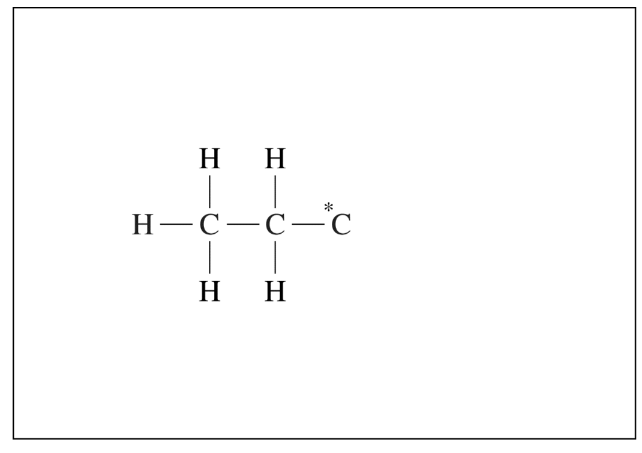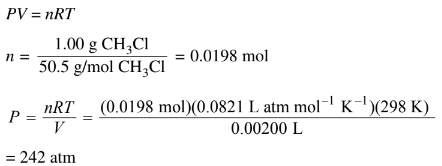Question
A student places a mixture of plastic beads consisting of polypropylene (PP) and polyvinyl chloride (PVC) in a 1.0 L beaker containing distilled water. After stirring the contents of the beaker vigorously, the student observes that the beads of one type of plastic sink to the bottom of the beaker and the beads of the other type of plastic float on the water. The chemical structures of PP and PVC are represented by the diagrams below, which show segments of each polymer.

(a) Given that the spacing between polymer chains in PP and PVC is similar, the beads that sink are made of which polymer? Explain. PP is synthesized from propene, \(C_3H_6\), and PVC is synthesized from vinyl chloride, \(C_2H_2CI\). The structures of the molecules are shown below.

(b) The boiling point of liquid propene (226 K) is lower than the boiling point of liquid vinyl chloride (260 K). Account for this difference in terms of the types and strengths of intermolecular forces present in each liquid.
In a separate experiment, the student measures the enthalpies of combustion of propene and vinyl chloride. The student determines that the combustion of 2.00 mol of vinyl chloride releases 2300 kJ of energy, according to the equation below.
\(2 C_2H _3Cl(g) + 5 O_2(g) → 4 CO_2(g) + 2 H_2O(g) + 2 HCl\)(g) \( \Delta H^0\)=-2300 kJ/mol
(c) Using the table of standard enthalpies of formation below, determine whether the combustion of 2.00 mol of propene releases more, less, or the same amount of energy that 2.00 mol of vinyl chloride releases. Justify your answer with a calculation. The balanced equation for the combustion of 2.00 mol of propene is
\(2 C_2H(g) + 9 O_2(g) → 6 CO_2(g) + 6 H_2O\)(g).

▶️Answer/Explanation
(a) The PVC beads sink. The spacing between chains is similar, but a Cl atom has a greater mass than \(CH_3\).
(b) Both substances have dipole-dipole interactions and London dispersion forces (or propene is essentially nonpolar with only LDFs while vinyl chloride has both LDFs and dipole-dipole forces). Propene contains a CH, group, but vinyl chloride contains a Cl atom. Vinyl chloride thus has a larger electron cloud, is more polarizable, and has a larger dipole moment. Thus intermolecular attractions are stronger in vinyl chloride, which results in it having the higher boiling point.
(c) ∆H°\(=6(-394) + 6(-242)-2(21)=-3858 kJ/mol_{rxn}\) The combustion of 2.00 mol of propene releases more energy.
Question.
Propanoic acid, \(C_2H_5COOH\), is an organic acid that is a liquid at room temperature.
(a) An incomplete Lewis diagram for the propanoic acid molecule is provided in the box below. Complete the diagram, showing how the remaining atoms in the molecule are arranged around the carbon atom marked with an asterisk (*). Your structure should minimize formal charge and include any lone pairs of electrons.

(b) Identify the hybridization of the carbon atom marked with the asterisk.
(c) Propanoic acid has a lower boiling point than butanoic acid, \(C_3H_7COOH\).
(i) Identify all the types of intermolecular forces present among the molecules in propanoic acid.
(ii) Which of the types of intermolecular forces that you identified in part (c)(i) is most responsible for the difference in boiling points of the two acids?
▶️Answer/Explanation
(a) There should be two O atoms attached to the C atom, one with a double bond and one with a single bond. The O atom attached with a single bond should have an H atom attached to it. Each O atom has two lone pairs of electrons. (Figure is required.)
(b) \(sp^2\)
c(i) London dispersion forces, dipole-dipole forces, and hydrogen bonding. (Identifying dipole-dipole forces is not required to earn the point.)
c(ii) London dispersion forces.
Question
Answer the following questions relating to HCl,\(CH_3Cl,\) and \(CH_3\)Br.
(a) HCl(g) can be prepared by the reaction of concentrated \(H_ 2SO_4\)(aq) with NaCl(s), as represented by the following equation.
\(H_{2}SO_{4}(aq)+2NaCl(s)\rightarrow 2HCl(g)+Na_{2}SO_{4}(aq)\)
(i) A student claims that the reaction is a redox reaction. Is the student correct? Justify your answer.
(ii) Calculate the mass, in grams, of NaCl(s) needed to react with excess \(H_2SO_4\)(aq) to produce 3.00 g of HCl(g). Assume that the reaction goes to completion.HCl(g) can react with methanol vapor,\( CH_3OH(g)\), to produce \(CH_3Cl\)(g), as represented by the following equation.
\(CH_{3}OH(g)+HCl(g)\rightleftharpoons CH_{3}Cl(g)+H_{2}O(g) K_{P}=4.7\times 10^{3}\) At400K
(b) \(CH _3OH(g)\) and HCl(g) are combined in a 10.00 L sealed reaction vessel and allowed to reach equilibrium at 400 K. The initial partial pressure of\( CH_3OH(g)\) in the vessel is 0.250 atm and that of HCl(g) is 0.600 atm.
(i) Does the total pressure in the vessel increase, decrease, or remain the same as equilibrium is approached? Justify your answer in terms of the reaction stoichiometry.
(ii) Considering the value of Kp , calculate the final partial pressure of HCl(g) after the system inside the vessel reaches equilibrium at 400 K.
(iii) The student claims that the final partial pressure of \(CH_3OH(g) \)at equilibrium is very small but not exactly zero. Do you agree or disagree with the student’s claim? Justify your answer.
(c) The table below shows some data for the compounds \(CH _3Cl \)and \(CH_3Br\).

(i) Identify all the types of intermolecular forces that exist among molecules in \(CH_3Cl(l)\).
(ii) In terms of intermolecular forces, explain why the boiling point of CH3Br(l) is greater than that of \(CH_3Cl(l)\).
(d) A 2.00 mL sealed glass vial containing a 1.00 g sample of \(CH_3Cl(l)\) is stored in a freezer at 233 K.
(i) Calculate the pressure in the vial at 298 K assuming that all the \(CH_3Cl(l)\)vaporizes.
(ii) Explain why it would be unsafe to remove the vial from the freezer and leave it on a lab bench at 298 K.
▶️Answer/Explanation
a(i) No, the student is not correct. None of the oxidation numbers of the elements change (H = +1, S = +6, O = -2, Na = +1, Cl = -1).
a(ii) 
(b)(i) The pressure will remain the same. The reaction stoichiometry shows that two moles of gaseous reactants produce two moles of gaseous products. Because the number of moles of gas does not change, the pressure does not change.
b(ii)The value of\( K_p\) is large, so the reaction will proceed to the right until the limiting reactant is essentially used up. Thus practically all of the \(CH_3OH(g)\) will react and the final pressure of HCl(g) is 0.600 – 0.250 = 0.350 atm.
OR

The final pressure of HCl(g) is 0.350 atm at equilibrium.
b(iii) Agree. The large value of \(K_p\) means that the partial pressure of the limiting reactant at equilibrium will be extremely small, but some \(CH_3OH \)molecules must exist for the system to be in dynamic equilibrium.

The partial pressure of \(CH_3OH(g)\) is very small but is not zero.
c(i) London dispersion forces and dipole-dipole forces
c(ii) The electron cloud in \(CH_3Br\) is larger and more polarizable than that of \(CH_3Cl\). As a result the London dispersion forces are stronger in \(CH_3Br\) compared to those in \(CH_3Cl\)and consequently the boiling point of\( CH_3\)Br is higher than that of \(CH_3Cl\).
d(i)

d(ii) At room temperature the liquid will vaporize. Consequently the glass vial may not be strong enough to withstand the increase in pressure.
